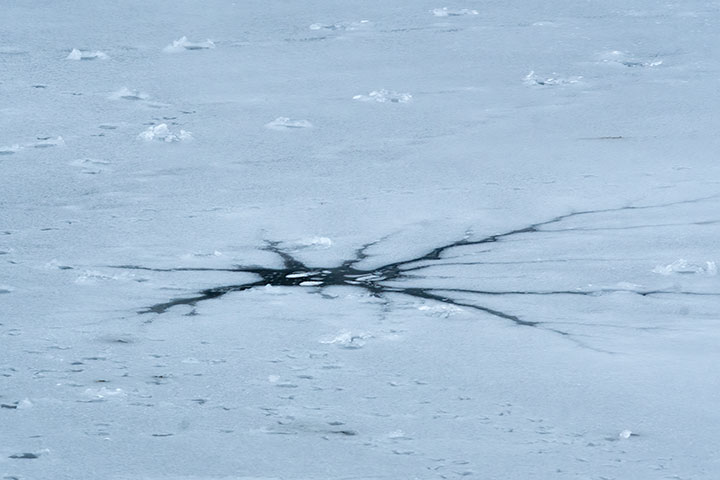We have all seen them: star-like patterns of melt on the shallow ice of bays.
With any luck, this posting will be followed by one with more information on these so-called lake stars, for much of their formation remains a mystery to me.
Over the years of casually noting lake stars, I had just assumed that they were the result of the drainage of surface melt water back through a hole in the ice. Evidence is accumulating that this is backwards. Here is what seems to be the consensus of the few who have explored the patterns.
• a new thin (a few centimetres) layer of ice forms over stratified water
• atop the ice, it is important that a thin layer of snow has fallen
• a small hole forms in the ice (Why does it form?)
• while the lake water immediately below the ice is at 0 °C, below that, it is warmer
• capillary action causes some warmer water to wick upwards onto the snow
• this arrived water depresses the ice surface increasing the flow of water
• arrival of increasingly warm water from below increases the melting
The formation of the arms of the star remain a mystery for me. However, what I had not realized is that the flow of water is up, not down. The snow atop the ice is a necessary feature because it serves to wick the lake water onto the surface. The wicking is important as it can bring up the warmer water from below, whereas buoyancy would not do so. (Water is densest at 4 °C so the warmer denser water lies a bit below the surface.) It also remains unclear to me why the lake stars form at some places but not others.
A common, but mysterious lake star forms in thin snow-covered ice on water.


Very interesting….look forward to more about these, which are seen early in the freeze-up on both Fish and Bear Lakes near Kaslo.
Thanks Alistair
We see these also on Sky Pond, the body of water that extends west of the house and gardens here at Edgewood Blue.
In our case, the weight of freshly fallen snow seems to cause the ice to deflect downward toward the middle of the pond, which in turn prompts water to flow in from the margins where, apparently, the stems of cattails wick it to the surface.
Consistent with this presumed centripetal flow, the arms of each pond star have a somewhat dendritic pattern – as also in your case.
These things being said, you make it clear that the story is much more complex that I had imagined.
Standing by…
Trevor
Thanks for revealing this never-seen-before-by-me natural phenomenon! Fascinating image.